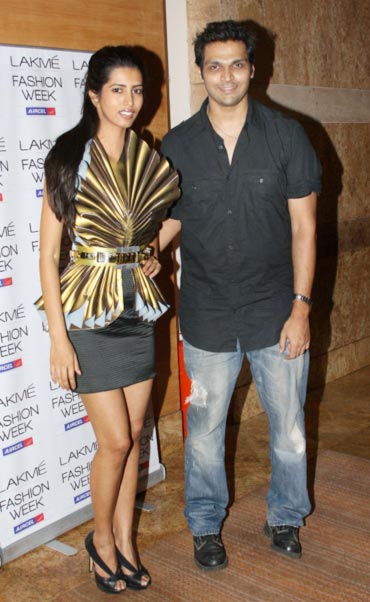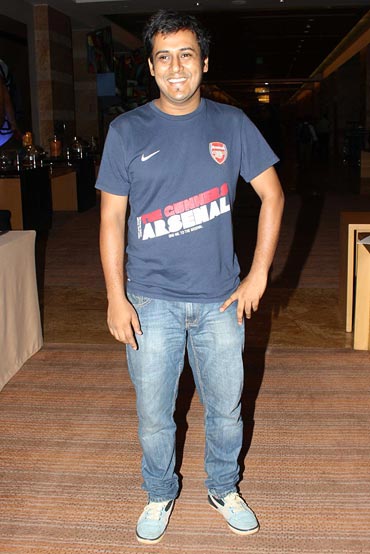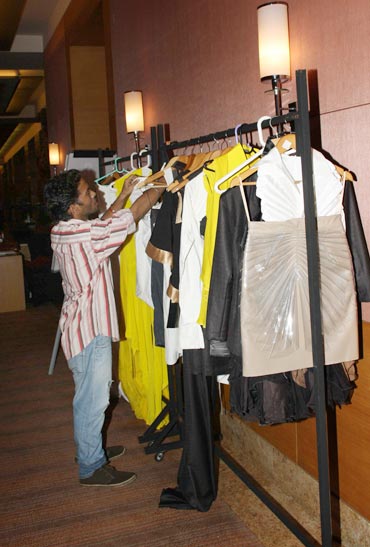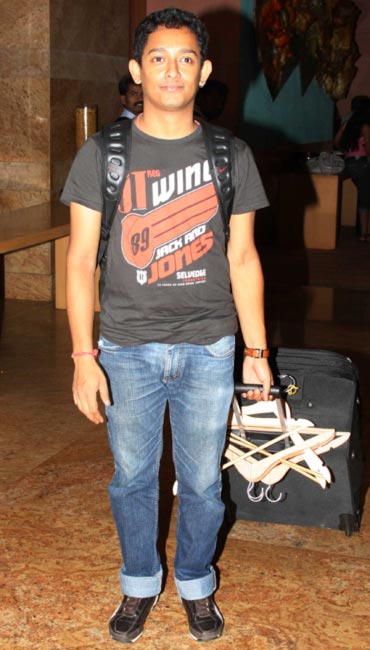Photographs: Hitesh Harisinghani Divya Nair
What does the LFW have in store for us this time around? Find out right here.
For the next few days, the Grand Hyatt in Mumbai will be synonymous with fashion and glamour, courtesy the Lakme Fashion Week's winter installment which will run from August 16 to 21.
We caught up with designers Swapnil Shinde, Shivaji Dutta and Amalraj Sengupta who gave us a sneak peek of their latest offerings and shared a few useful fashion tips.
Seasons ago, Swapnil was among the first crop of GenNext designers to showcase their talent at the Lakme Fashion Week and has been a regular participant since then. This time around, his showing is sponsored by courier giant DHL and the inspiration behind the collection is 'speed'.
He desires to make fashion affordable to all by designing clothes that are in vogue, yet don't cost you a bomb.
Can you tell us about your latest collection?
Shilpa (littleshilpa), Nachiket (Barve) and I are representing DHL and the brief they gave us involved using speed as the theme. I chose to showcase the speed of sound.
What are you going to showcase in 'Speed of Sound'?
When you think of sound, the first thing that comes to your mind is sound waves, the ripples. I have tried to use the same in my designs. I have tried to recreate ripples and the wave-like patterns in my collection.
What colours and fabric have you used?
I have used a lot of faux leather, plastic, acrylic and PVC material. Since DHL, our sponsors wanted to use yellow and red, you will see an influence of those colours. I have personally used yellow, it really stands out. I am also using the regular blacks and whites, grey, beige and other neutral colours.
What is the average price range for your designs?
The average cost should be between Rs 20,000-25,000.
'Do not blindly ape trends because everyone else is doing it'
Image: Little Shilpa gives us a sneak peek of what she's working on for the DHL showing at the LFWWhat is your idea of fashion?
I intend to make clothes that are affordable. My target audience is anyone between 16-28 years of age. These are people who define fashion for me.
Guys and girls in this age group are either studying in college or are young professionals. They are always on the lookout for fashion, to find something affordable to wear for a girl's night out or a late evening party.
The clothes I make are designerwear but they are affordable enough for the college crowd as well. For instance, the price range for formal tops would start from Rs 850, while short skirts and eveningwear will start from Rs 2,000 onwards. Gowns are priced Rs 10,000 onwards.
In your opinion, what is the biggest fashion blunder that people make?
There are a few of them who try to ape popular celebrities. This could be a model aping another model or a designer aping another designer.
Some of them think it is easy to ape and get away with it, no one will know. One needs to understand that a celebrity is a styled personality and style is a distinct characteristic.
What is your advice to young aspirants and budding designers?
The competition is tough and unless you are able to develop a signature style for yourself, you are not going to survive in fashion for long.
You need a lot of patience and lastly, but importantly, you need strong technical knowledge of fashion, from fabrics to design to target audience to market. You need to have sound knowledge of the industry you intend to work in.
What fashion tip would you give GenY?
Fashion is not about following trends. Do not blindly ape trends because everyone else is doing it. What is 'in' today may be out tomorrow. Wear what you like, wear what suits you and carry it off with attitude.
'I don't believe in recycling, I believe in reusing'
Image: Shivaji Dutta at the LFW fittings"One man's waste is another man's treasure," is what Kolkata-based designer Shivaji Dutta believes.
Interesting as his sensibilities are, Shivaji Dutta, a student of NIFT Kolkata loves creative freedom and wants to open a unique solution store in the country where people can come and dump their old clothes and take them back completely revamped. Sounds cool!
What's your collection all about this season?
I am trying to use old leftover fabrics and material to create something new and original.
What inspired you to come up with such a concept?
Well, I have always believed that it is easy to create fashionable designs from new material. However, it is challenging to be able to create something from leftover material.
What do you mean by 'leftover material'?
You see, most designers would agree that when they design clothes, a lot of material gets wasted. These may be tiny bits of clothes or fabric like leather or denim.
I have also seen a lot of young girls and men who discard their clothes just because they are no longer in fashion or because of tiny defects. I thought, why not use these clothes, work on them, tweak them a little and present them as something new and fashionable?
By doing so, I realised that I am not only spending less on buying a new material, but I am also able to create something different and unique.
'I have made some really horrible-looking garments!'
Image: A designer's assistant puts a collection rack in orderWhat pushed you to develop this initiative?
It's like a Greenpeace initiative. Everybody wants to do something, but nobody wants to take a step.
Countries like India and China consume the largest amount of energy and raw material.
In fact, most of them talk about recycling as a remedy to green environment. I don't believe in recycling. To me, recycling again adds to the expenditure of manufacturing. I believe in reusing material.
What colours are you using?
You will see a lot of blues, blacks, greys and whites.
What is your price range like?
It should be anything between Rs 12,000 to 20,000.
What is the one fashion blunder that people make?
Copying. Besides, if you ask me, a design is never right or wrong. Fashion is a very subjective term.
What is your biggest learning from the industry?
I have learnt to make bad garments. I have made some really horrible-looking garments (laughs).
Who are your favourite designers?
I really like the work of Amalraj Sengupta, Kallol Dutta and Anuj Sharma. These are the new crop of designers and they really showcase unique concepts in design.
What is your advice to aspirants and budding designers?
Most of them think of the market first and then design clothes accordingly. I think this is where most of them go wrong initially. As a designer, it is important that you first create an identity for yourself and your designs and then pay attention to the market than vice versa.
What are your plans for the future?
I want to open a unique solution store where people can come with their old, out-of-trend clothes and give them to me. They can share their ideas about what they want. I shall develop them into an altogether new version which they can mix and match with and it gives them the advantage of saving some money too.
'I have realised that my designs don't sell in India'
Image: Amalraj Sengupta wheels hangers and trolleys full of his creations out of the fitting roomsAt 25, Amalraj Sengupta is a brilliant example of 'spoilt with style'. Barely five seasons old, he is already a name to reckon with among the younger crop of Indian designers.
He loves martial arts and is inspired by the movies. His design concepts are young, promising, out-of-the-box and avante garde to say the least.
How did the LFW happen for you?
I was a student of NIFT, Kolkata. After college, I was freelancing for some designers. In 2009, I sent my designs for the Lakme GenX auditions and I was chosen at the entry level. The following two seasons, I was in the 'Emerging' category and this is my fifth season at LFW. It feels great!
How have you matured as a designer in the past few seasons?
For me, the best part of the LFW is the feedback that we receive about our designs. Besides, my personality has improved. I have learnt how to talk (smiles).
I clearly remember my first season at LFW. After the show, I had to address the press and I was so nervous and shy that I used to shiver. The public relations team had to literally hold my hand so that I could concentrate and talk properly.
What is your idea of fashion?
Designs and fashion come and go. I believe in setting trends. I like creating designs that are out-of-the-box. At the same time, I don't just want to showcase my clothes and forget about it. I want these clothes to sell off the ramp as well.
Where do you draw your influences from? Tell us about your collection.
I am a huge fan of martial arts. Bruce Lee is my favourite. I am also inspired by Asian culture and designs. I like asymmetrical designs. For example, my first collection was called 'Kendo'. It's a martial arts form dealing with sword-fighting.
My second collection was 'Decode'. It was inspired by the movie Transformers. It was mostly leather jackets, that could transform and assume the form of sleeping bags, like the ones campers use when they travel.
My third collection was called 'Ruins of World War II'. It was based on deconstruction. It was mostly black in colour. I also used red, like stains of blood on the clothes to bring on the feel of war.
The fourth season, my last collection was based on the game of Chess. I replicated the soldiers and players in my design by using black and white. The response I got was amazing.
My collection for this season is called 'Hard and Soft'. Intriguing as it is, I have tried to use hard materials like leather and given them the soft look. For example, I have made use of leather for drapes, and I have used georgette, which is a soft material and given it the hard look.
That's interesting. And what colours have you used?
I have used pinks, greys, blues, black and white and peach.
What is the price range for your designs?
It is anything between Rs 5,000 to 12,000.
'You see a lot of girls wearing revealing attire constantly trying to cover themselves'
Image: We caught Nachiket Barve in action, working on a model fittingIn your opinion, what is the one fashion blunder that most people make?
People need to understand their body type and wear clothes that will augment their body. What most of them do is if they like what someone is wearing, they also wear it, thinking it will look good on them.
What may look good on one may not always look good on you. For example, whenever I see some fat people wearing really tight-fitting clothes, that do nothing but show off their chunks of flesh in the wrong areas, I think it is fashion gone wrong.
Secondly, it is important that you are comfortable in what you are wearing. You see a lot of girls wearing revealing attire constantly trying to cover themselves or adjusting their straps etc or then some wear high heels and try hard to balance. This is uncalled for. If you are not comfortable, it shows and it's a bad sign.
Who are your favourite designers?
I personally like Manish Arora, Sabyasachi, Alexander McQueen, Hussein Chalayan and Yohji Yamamoto.
What are your other interests?
I love watching action movies, playing video games. I also like collecting watches and shoes. Puma is my favourite brand for shoes.
What is your advice to aspirants and budding designers?
It is very important that you know what you want to do -- whether you want to make money, create an identity, set trends or want to get into mass production. You may not get all at the same time.
You have to be patient enough to go through each of these stages gradually and decide for yourself where you want to make your mark in. For example, if you want to get into mass production, you may not be able to create designs and please your creative side.
Similarly, if you want to do something for yourself, you may not earn much money initially, or become famous, for that matter. But you will be able to create an identity for yourself. It is up to you what you want and how you plan to take your passion ahead.
What is your opinion about the industry at large? Many youngsters, especially models are apprehensive about the people in the profession.
It all depends on how you present yourself. There will be good people and bad people. Luckily, I have only worked with good people so far.
But I think most of what happens to you is because you choose to let it happen that way. I agree, most designers look at models like hangers, which display their collections on the ramp. While that may be true, both designers and models have to behave like professionals and understand what is required and act accordingly in mutual respect of each other.
It is a healthy industry and it is booming like never before. So, I don't think these things should matter much.
What is your fashion tip to youngsters?
Be comfortable with what you wear or wear what you are comfortable wearing. The vibe will be evident in your attitude.
What are your plans for the future?
I have realised that my designs don't sell in India. People here are still not open to Westernised designs. I plan to target the international market. Let's see how it works.







Comment
article